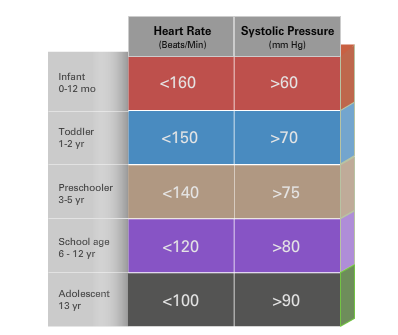Cardiovascular System
- Higher resting heart rate and lower resting blood pressure.
- Compensatory ability for blood loss:
- Early signs: tachycardia, poor skin perfusion, altered mental status.
- Decreased blood pressure is a sign of decompensated shock.
- Lower total blood volume.

Hypovolemia is the leading cause of shock in the pediatric patient. In trauma, this is usually the result of hemorrhage. Understanding the patient's cardiovascular response to trauma will improve management of the injured child. Children have a higher resting heart rate in order to meet their higher metabolic demand. They also have a lower blood pressure due to a decreased cardiac output and peripheral vascular resistance. Children may lose up to 25% of total blood volume before the systolic blood pressure drops. When distressed, cardiac output, CO, is increased by accelerating the heart rate. In addition, catecholamine release stimulates intense peripheral vasoconstriction to maintain mean arterial pressures. Emergency providers must recognize subtle signs of hypovolemia such as tachycardia, altered mental status and poor skin perfusion including delayed capillary refill, cool extremities and mottled skin. Children have a lower total blood volume than adults, therefore, what may appear to be small amounts of blood loss, can be a significant percentage of blood volume.